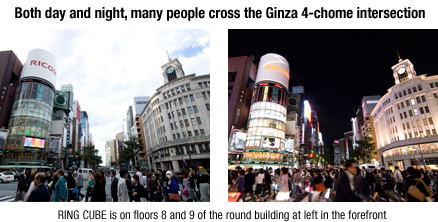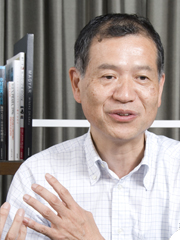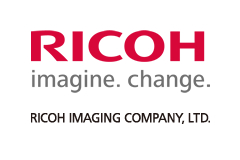Inside Story


- To create the space
- To show photographs
- To take photographs
Customer communication in a "real" place

"It was my long-time dream for Ricoh
to open its own photo gallery.
(Tomohiro Noguchi)
On October 21, 2009, the Ricoh photo gallery RING CUBE reached its first anniversary. Located on the eighth and ninth floors of the San-ai Dream Center, a round building on a corner of the Ginza 4-chome intersection, RING CUBE is currently (as of this writing) presenting the "9th Ricoh Photo Contest Winning Photo Exhibition," from October 7 to November 1, 2009. The theme of the contest is "Laughter." This is a photo exhibition that is bound to put a smile on your face and provoke comments such as "Now, that's funny!" and "What a great shutter chance!"
"It feels like two or three years have gone by," says Tomohiro Noguchi gazing across the gallery with deep emotion. For many years he had waited and hoped for a gallery to be opened. The head of the Personal MultiMedia Products Company Planning Office, Noguchi is involved in digital camera planning.
RING CUBE
9th Ricoh Photo Contest Winning Photo Exhibition

"In August 2005, the official Ricoh blog "GR BLOG" was established to enable Ricoh employees to, in their own voices, provide a variety of information concerning the Ricoh digital camera GR DIGITAL. The direct two-way communication with customers spurred new camera development, photo contest creation, and other initiatives. The deeper this exchange with customers became, the more I came to want to communicate in a 'real' place," Noguchi said concerning the motivation for opening a gallery. "I imagine that fully realized communication can also take place in the virtual world, but I think that communication drastically deepens when it is paired with a real space where texture, smell, sound, and much else can also be perceived. I wanted to provide such a space."
GR BLOG(Japanese)
"Printed photographs have
a different appeal than digital data."
(Masanori Hashimoto)
Masanori Hashimoto, RING CUBE operation leader and general manager in charge of the Personal MultiMedia Products Company Planning Office, had this comment: "This year's photo contest is the ninth held by Ricoh, and of those nine, actual physical exhibitions of the winning works have been held five times. When this is done, people come to view the photographs from abroad as well as from Japan, and I feel there is a big difference between viewing a photograph as image data on a PC and viewing it displayed as a print in a gallery setting." Because of such strong enthusiasm on the part of the people involved, a gallery was established in the San-ai Dream Center building at the Ginza 4-chome intersection. The San-ai Dream Center building and the Wako Building (clock tower) facing it across the intersection are symbolic presences for Ginza. But why was such a prime real estate locationchosen?
Ricoh has an emotional attachment to Ginza
To tell the truth, San-ai Dream Center is a historically significant location for Ricoh. Immediately after World War II, Ricoh founder Kiyoshi Ichimura (1900-1968) decided "For Tokyo's recovery and our own, if we are going to open a store on the burned out plain of Tokyo, it must be at Ginza 4-chome. "After many desperate visits to the land owners—Yasuda Bank and Sanoya, a venerable tabi (Japanese sock) merchant in business since the Edo period—he succeeded in leasing this important plot of land. In 1946, the two-story San-ai Building was built, and in 1963 it was replaced by San-ai Dream Center, a cylindrical glass-walled building supported by a single central pillar, with a design hint being provided by the five-story pagoda at Horyuji temple in Nara Prefecture. The new building became a Ginza symbol. "In a sense, that building is also one of the symbols of the Ricoh brand," said Hashimoto.
Founder Kiyoshi Ichimura(Japanese)San-ai Dream Center history(Japanese)


